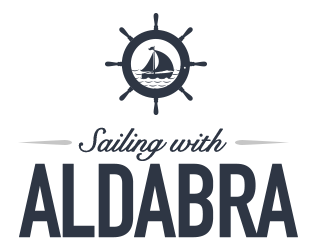As I’m sure I’ve mentioned, the passage to or from New Zealand is notorious, which is why we hired a professional weather router for the passage to New Zealand and now the passage away from New Zealand. Just as we were gearing up to leave after our first weather delay, our router convinced us to delay again. Hanging out on the boat in Opua was cold and we needed to keep ourselves entertained. On Saturday, May 11, Dale and Katrina on Womble took us on an outing over to the nearby town of Russell, where we followed a nice walk to a lookout and had a yummy pizza lunch in town. Later that afternoon, we had a rental car delivered to us at the marina.
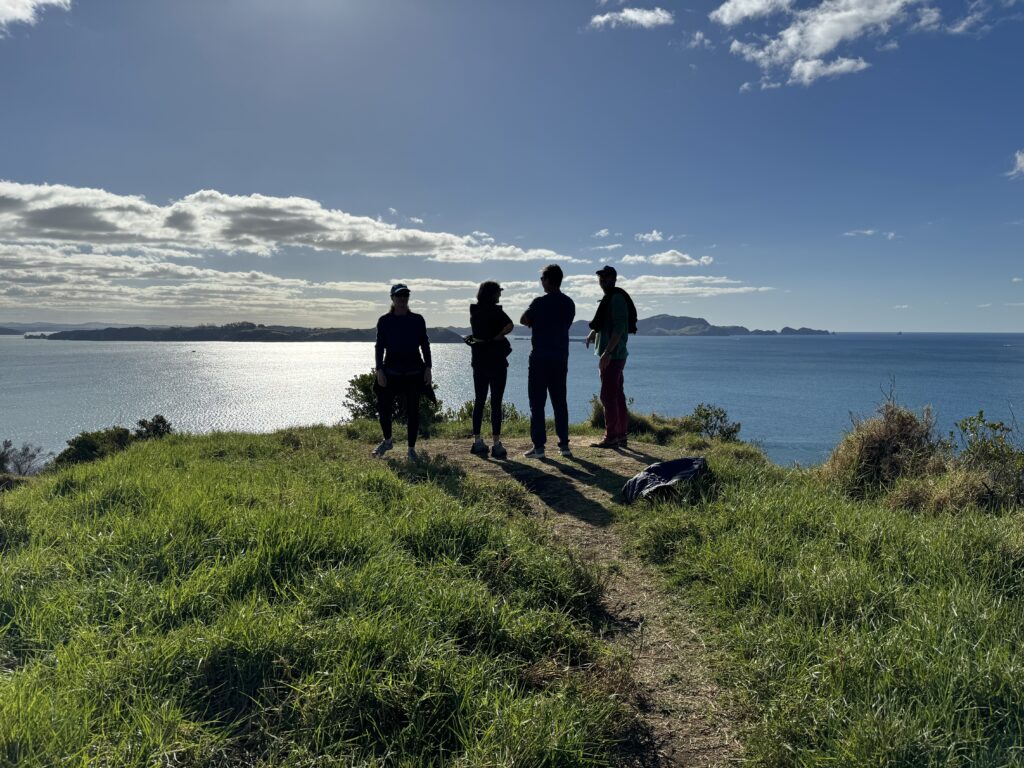
Checking out the Bay of Islands from the lookout near Russell
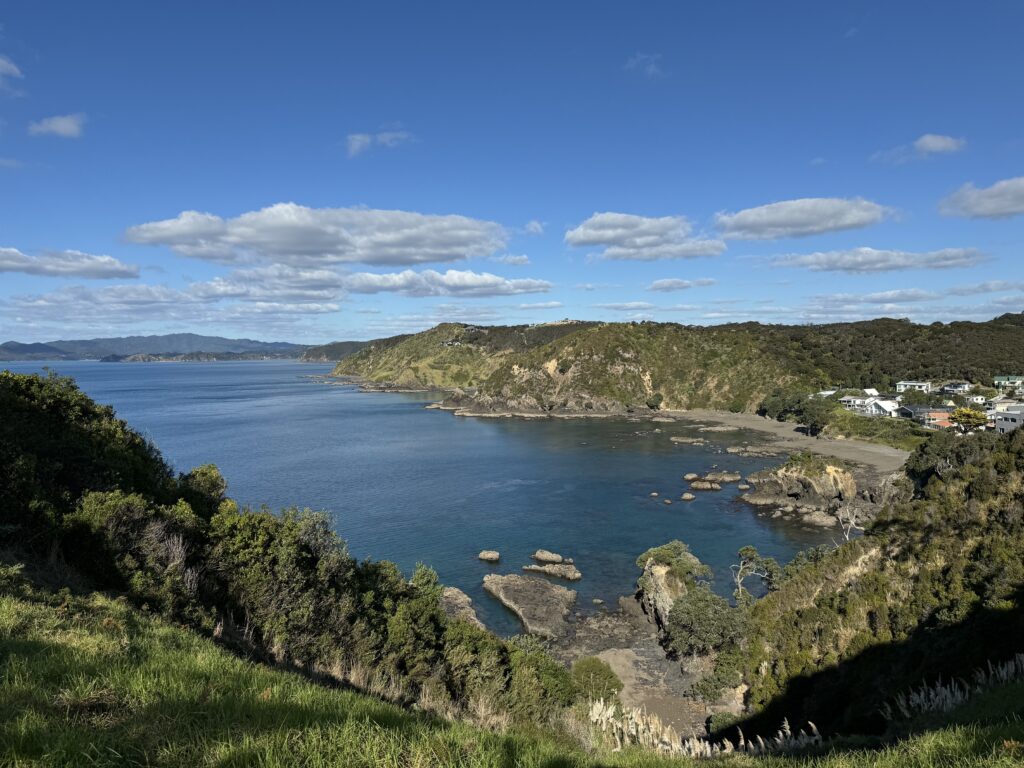
From the lookout near Russell
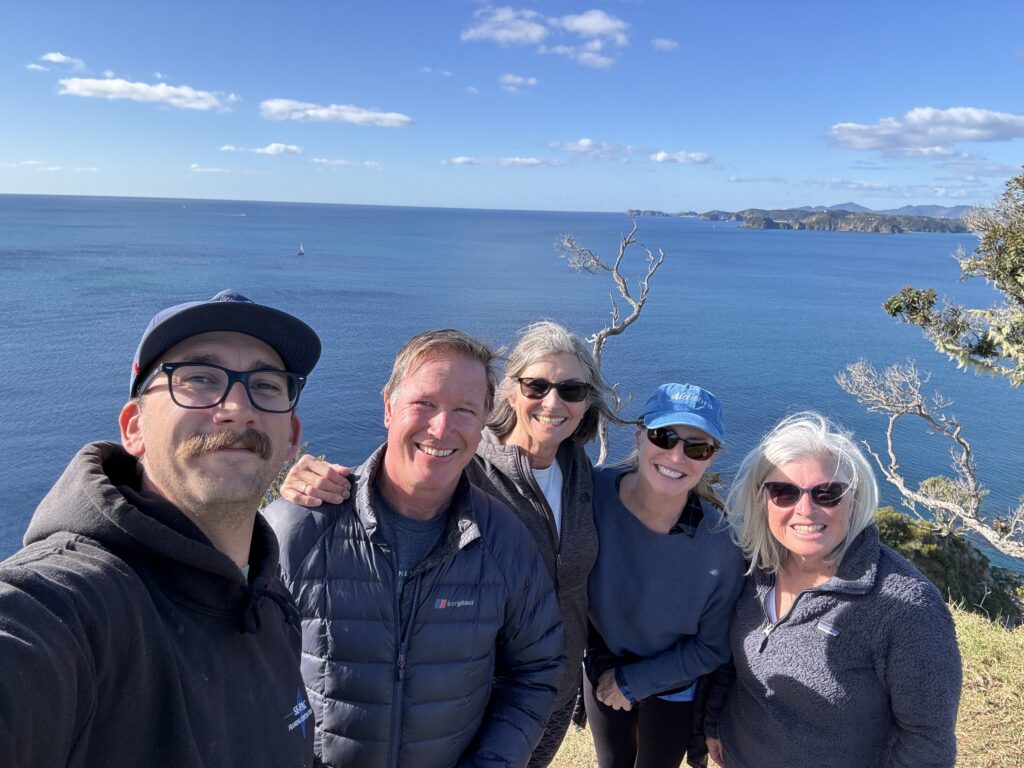
Aldabra and Womble near Russell
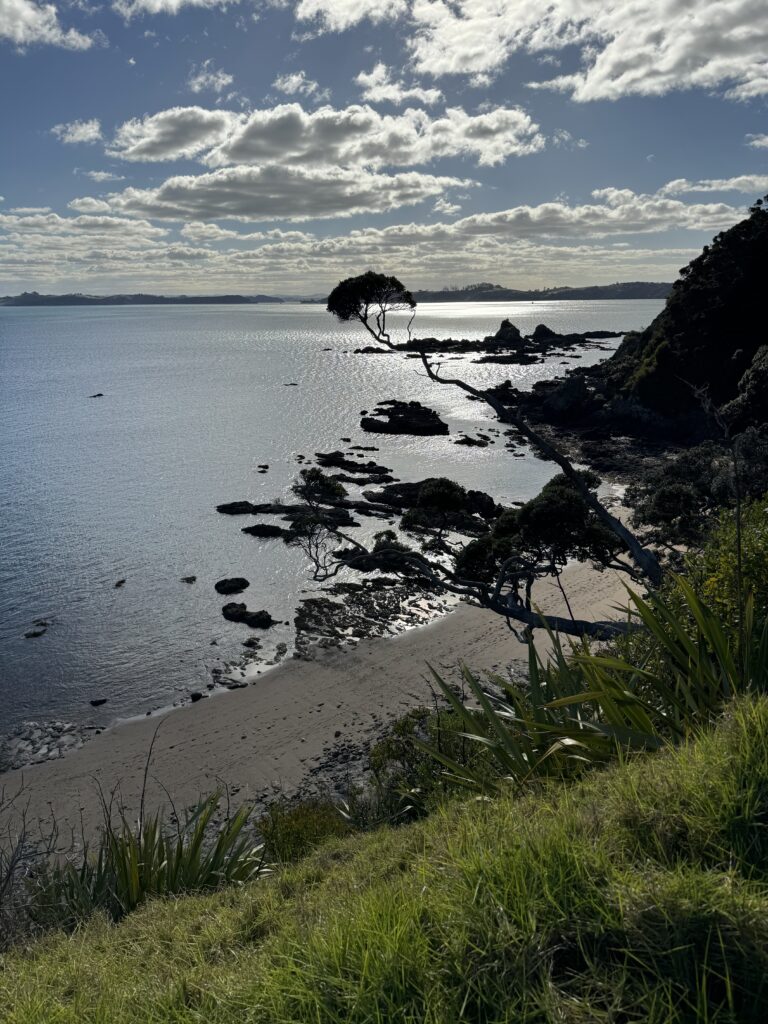
One more Bay of Islands shot
On Sunday, May 12, Johno, Stephanie and I left early in the morning and drove north to Cape Reinga, the northernmost point in New Zealand. The drive there was entrancing as we motored through a giant pastoral setting of farmland, hills and forests. At the cape, we walked to the lighthouse and then took a track down to the beach and back.
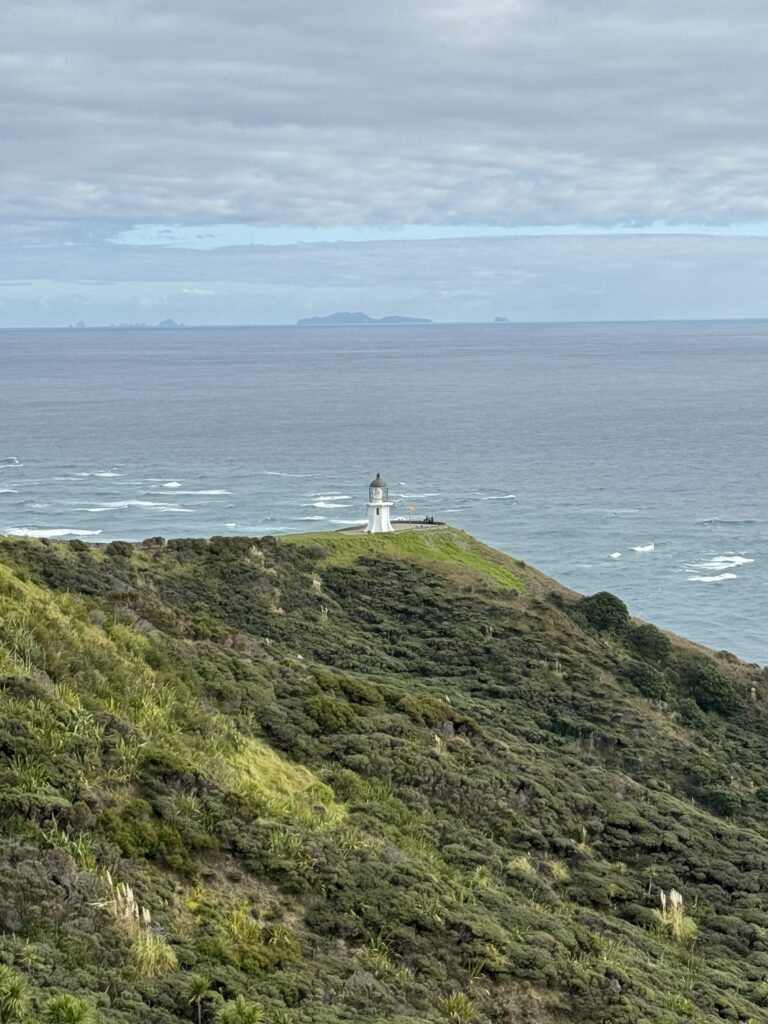
The Lighthouse at Cape Reinga
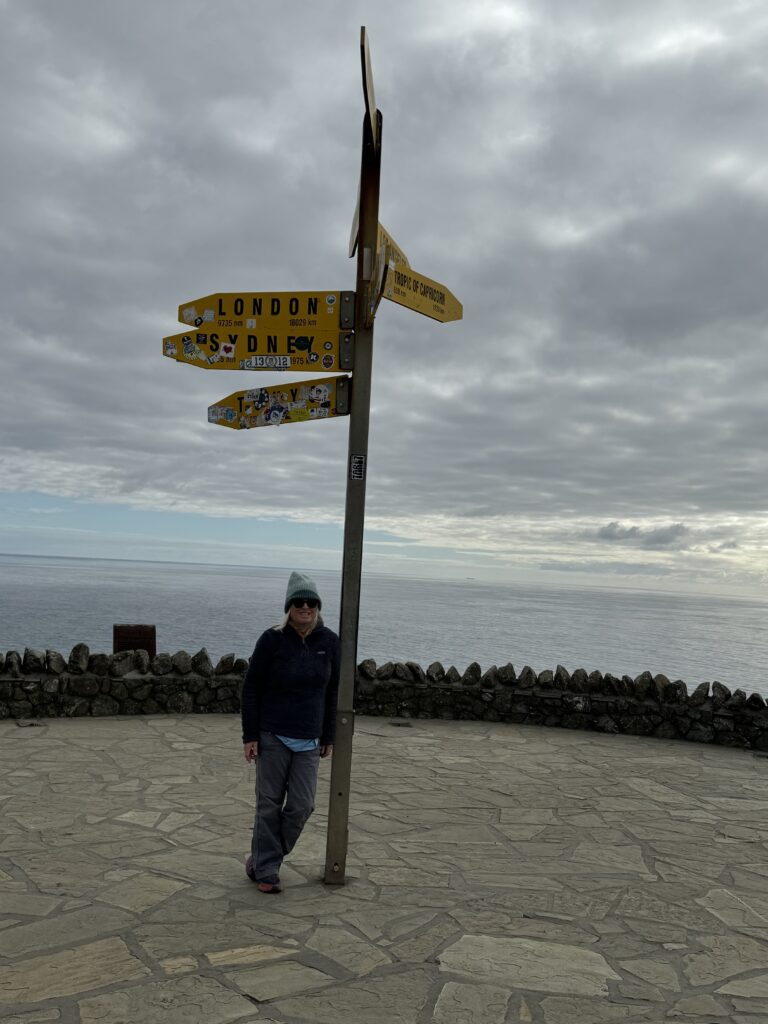
At the lighthouse
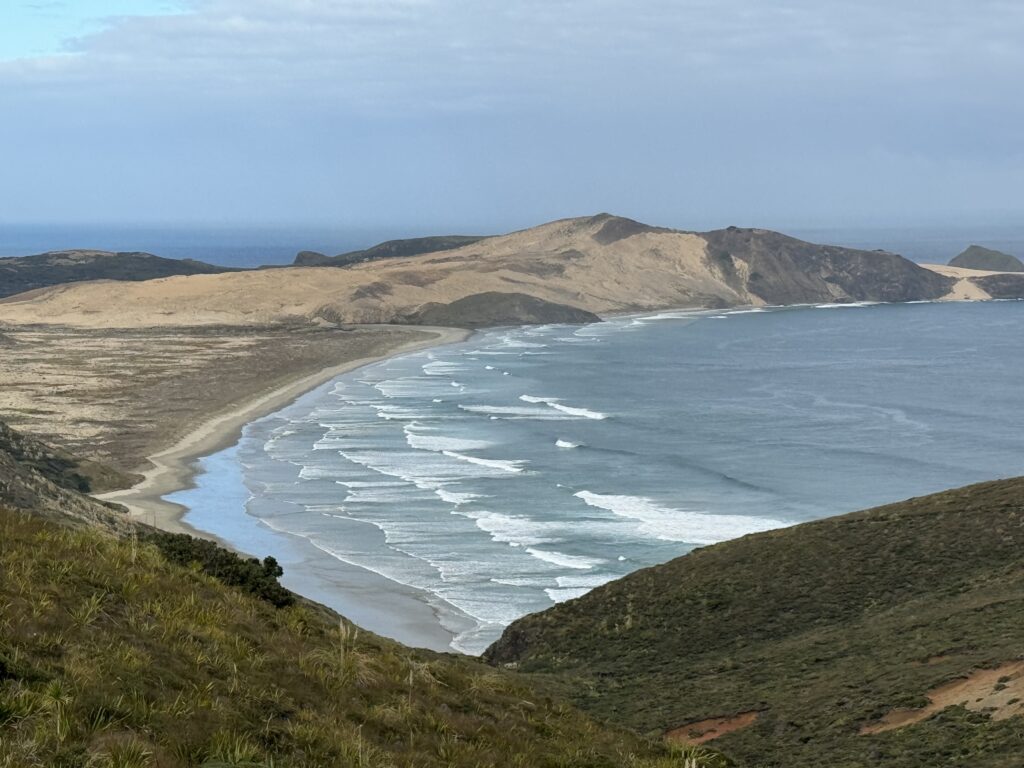
We walked the track that led to this beach and then walked along the beach
We then drove south to the dunes on the west coast and slid down on a boogie board after hiking to the top of one of the dunes.
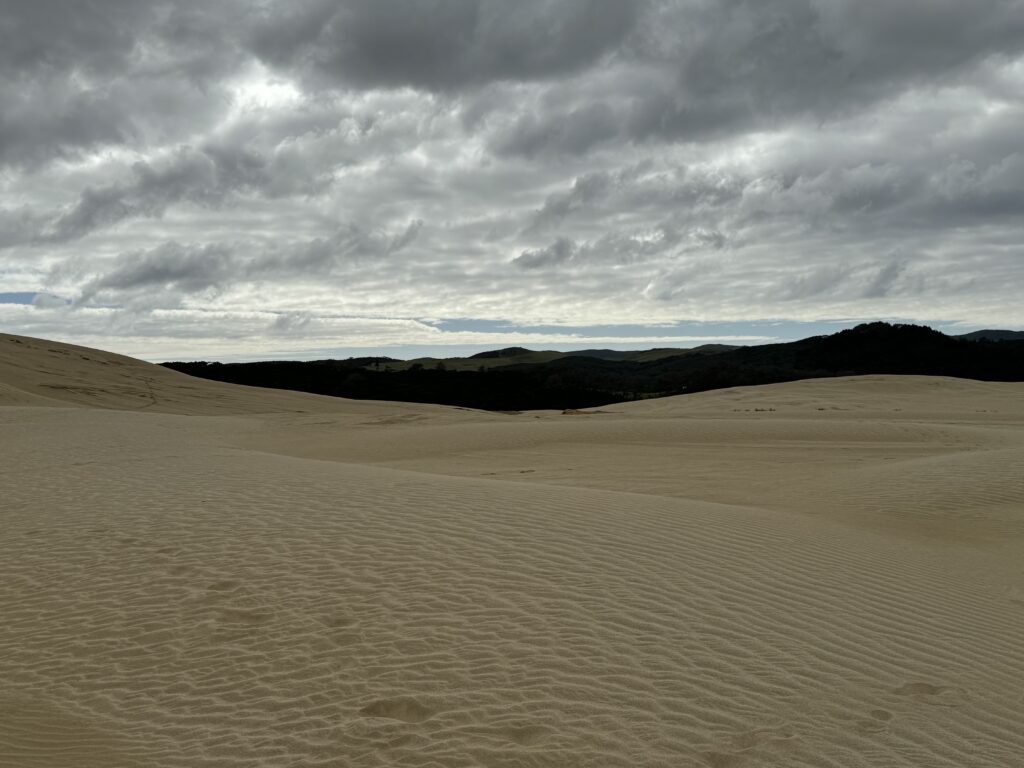
At The Dunes
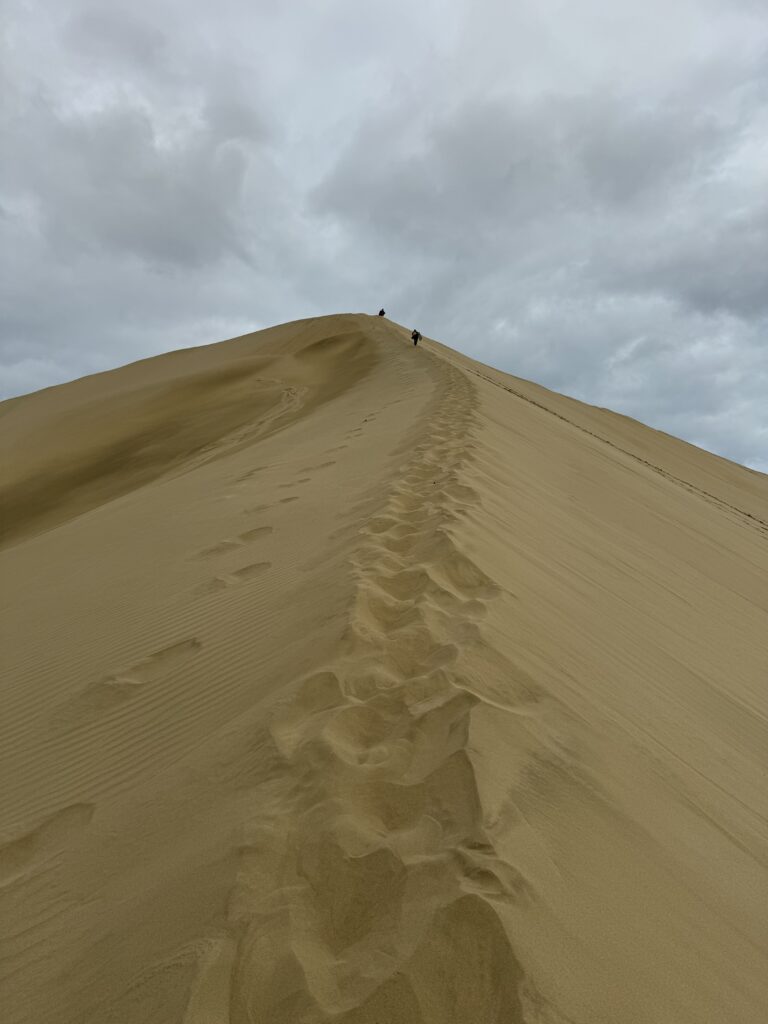
Walking to the top of the dune
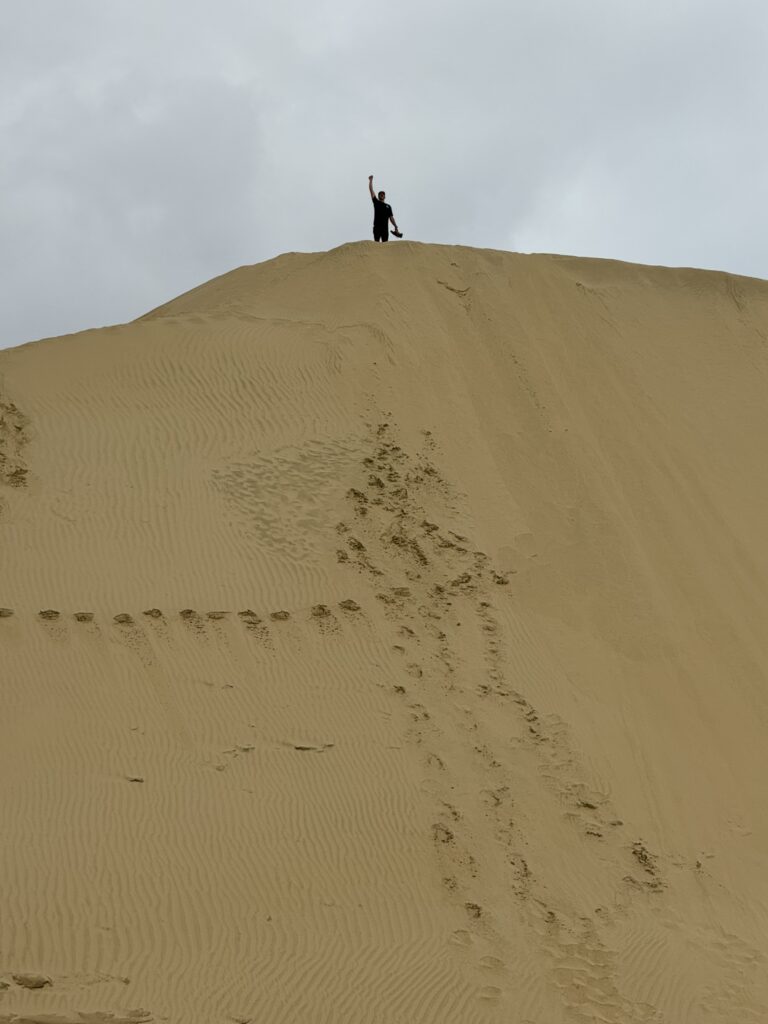
Johno at the top of a dune
Johno sliding down the dune
In the mid-afternoon we checked into an AirBnB in Pukenui and then walked a short distance to a restaurant for burgers. After lunch, we drove to 90-mile beach and took in the breathtaking sight of such a large expanse of wide, hard-packed sandy beach. We stayed almost to sunset before returning to the rental house.
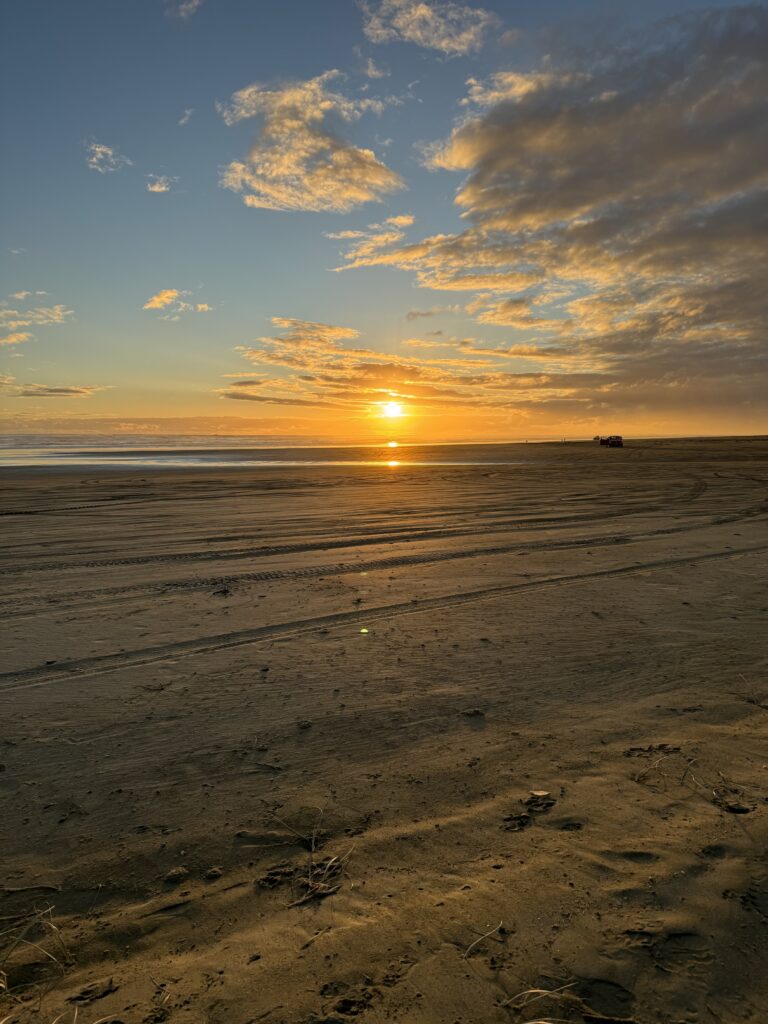
90-Mile Beach
On Monday, we left Pukenui and found a breakfast place on the way. Then we drove to Kerikeri and went for a walk and had a late lunch at the Plough & Feather restaurant before returning to Opua.
On Tuesday, Alex and Yvette from Blue Beryl joined us and we took off in the car. Our goal was a glowworm cave, but it turned out to be a very expensive tour, so we ended up in Kerikeri, checking out hardware stores and second-hand shops and getting a bite to eat.
The next day, Johno and I stopped by Blue Beryl for a visit and met Finn and Talissa on Beluga. Then we set off to hike from Opua toward the town of Paihia. The walk winds around the edge of the bay and it is quite nice. On the way back, we got stung by wasps. A woman and her dogs were right in front of us and must have disturbed a nest. Johno had what seemed like one sting on his ankle. I had what seemed like six or seven on my calves. The stings were pretty painful but we kept walking back to the boat and didn’t really treat them, although I think I took an antihistamine. (As the days progressed, it became clear that each wasp had stung us multiple times in each spot, so I probably had dozens of stings. Johno’s ankle ended up swelling so much it was hard to walk for a bit. And my stings just kept oozing and itching for many days.)
On Friday, May 17, Johno and Stephanie and I set off on another road trip. This time we drove west to the Kauri forest, where we saw two of the oldest, largest Kauri trees alive. The forest also had an abundance of smaller Kauri trees. A very nice ambassador, Henry, answered our questions about the trees and the other inhabitants of the forest. That night, we stayed in Hokianga, at the Sands Hotel, north of the Kauri forest. We had a lovely dinner and a nice breakfast the next day.

In front of the Kauri tree
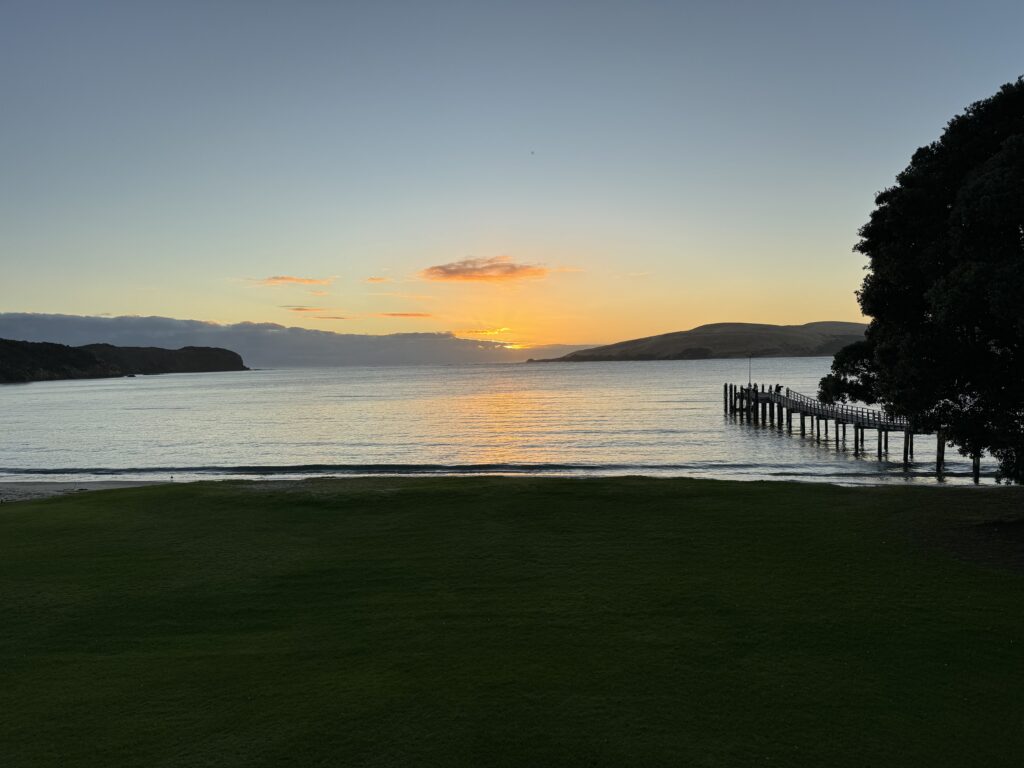
Looking out from the hotel room in Hokianga
The next day, on a whim, we drove south again, much farther than expected, to the Kauri Museum, which provided a thorough collection of photographs and antiquities from the days of triumphantly logging Kauri and clearing the land for farming. We stayed for a few hours and then took the long drive back to Opua, arriving just before nightfall.
On Sunday, May 19, Johno and I drove to the farmer’s market in Paihia and then to Bunnings, where we broke down and bought a space heater for the boat. It was still just too cold.
On Monday and Tuesday, we bought a few groceries in Paihia before returning the rental car. Then we did final chores on the boat in preparation for departure.
On Wednesday, May 22, we checked out of the marina and then checked out of the country. Once checked out, you are instructed to leave immediately. So we returned to the boat, cast off the lines around 11:30 a.m. and set off for Minerva Reef. Blue Beryl and Beluga were right in front of us and Southern Star left a bit after us, as did Antinea. Womble and Yuva planned to depart the next day.
Leaving Opua with a double-reefed main and full jib, the winds were light and the seas pretty mild because we were still in the protection of the Bay of Islands. We were mindful that you can’t dilly dally on the passage north from New Zealand because weather systems change and you don’t want to be caught up in something unexpected. So we motor sailed several times in those light winds north from Opua. Once we were out of the protection of the bay, the sea state was very confused and the winds were out of the southwest at 12-18 knots, with squalls up to 25 knots. Eventually the swells lined up more behind us and we made 145 nautical miles in the first 24 hours.
The sea state the next day was pretty similar to the first day. The winds were maybe a bit more consistent, but we were being pushed west from the rhumb line. We did our first three collections of water samples for our Citizens of the Sea project. Each time, we would drop the torpedo (which contained a filter) into the water and drag it for five minutes. Then we would retrieve the torpedo, put the filter in a vial, and repeat twice. We did that at 10:00 a.m. each day of the passage.
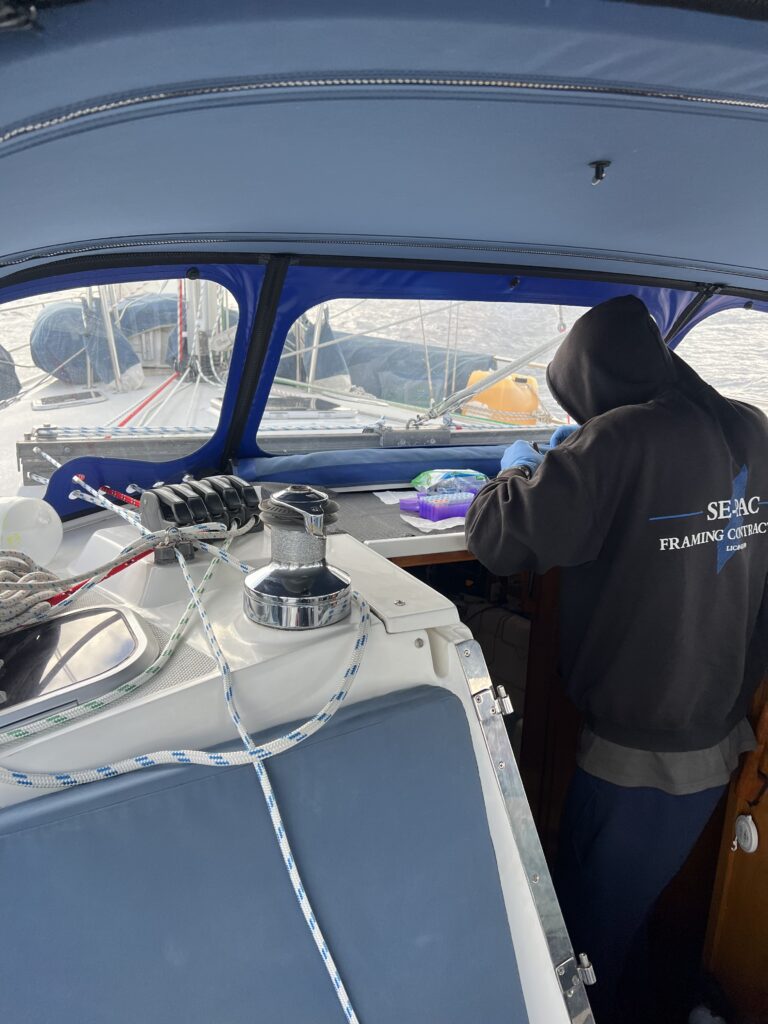
Johno doing our daily lab work for Citizens of the Sea
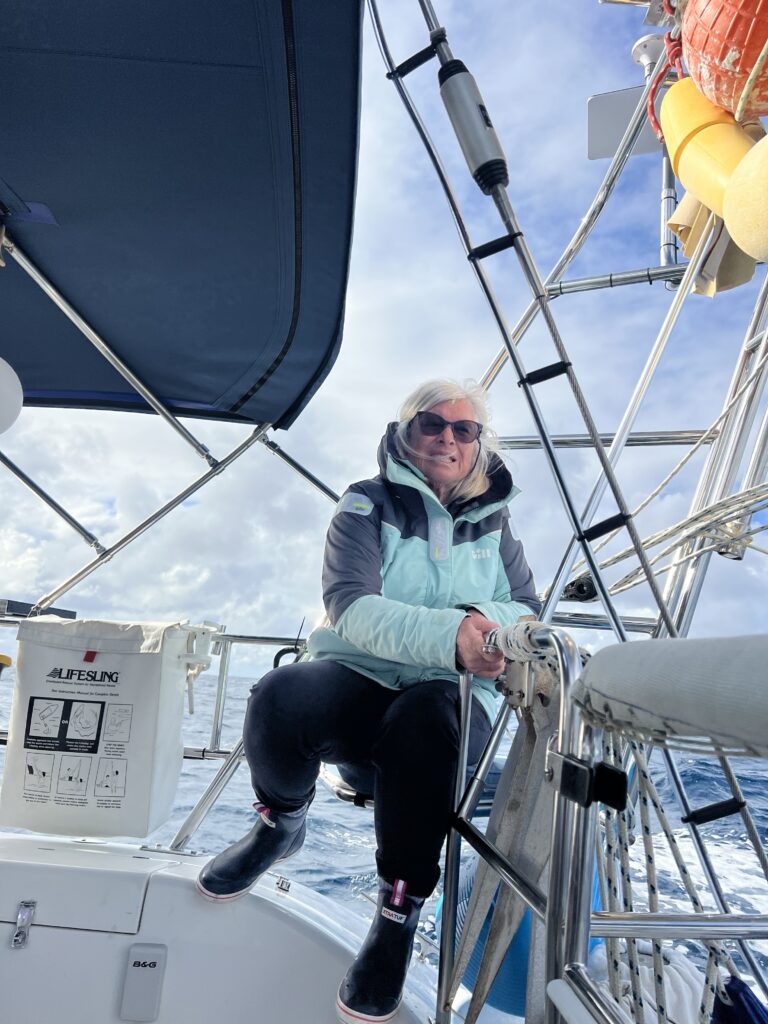
Waiting to retrieve the torpedo
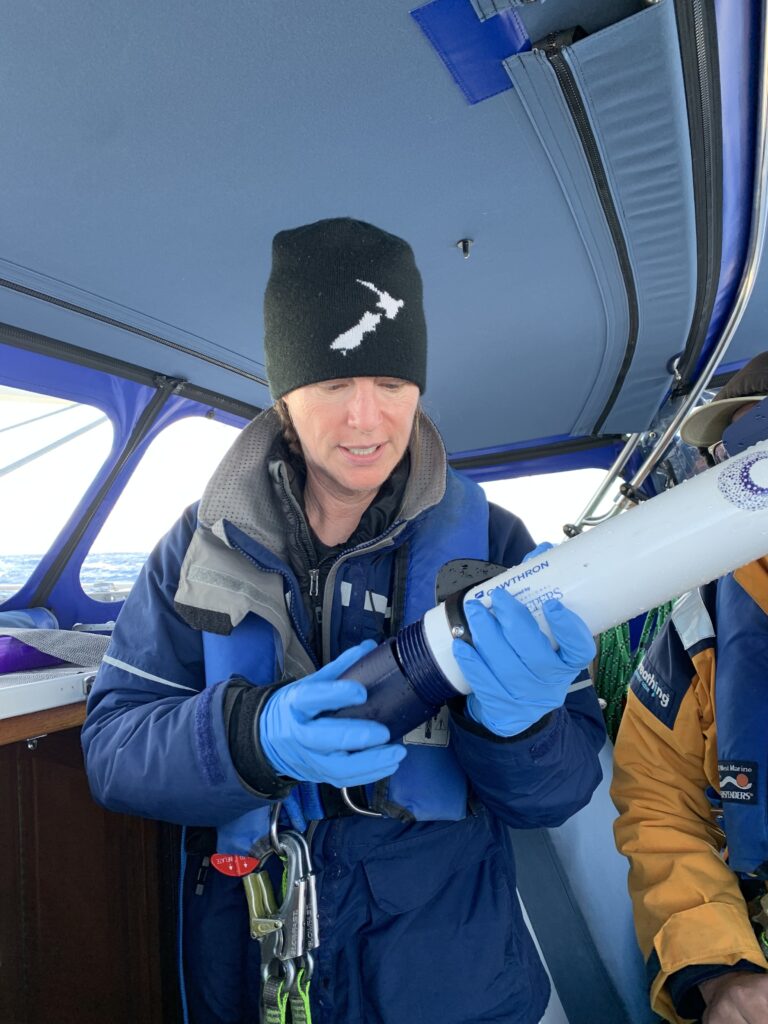
Stephanie getting ready to remove the filter from the torpedo
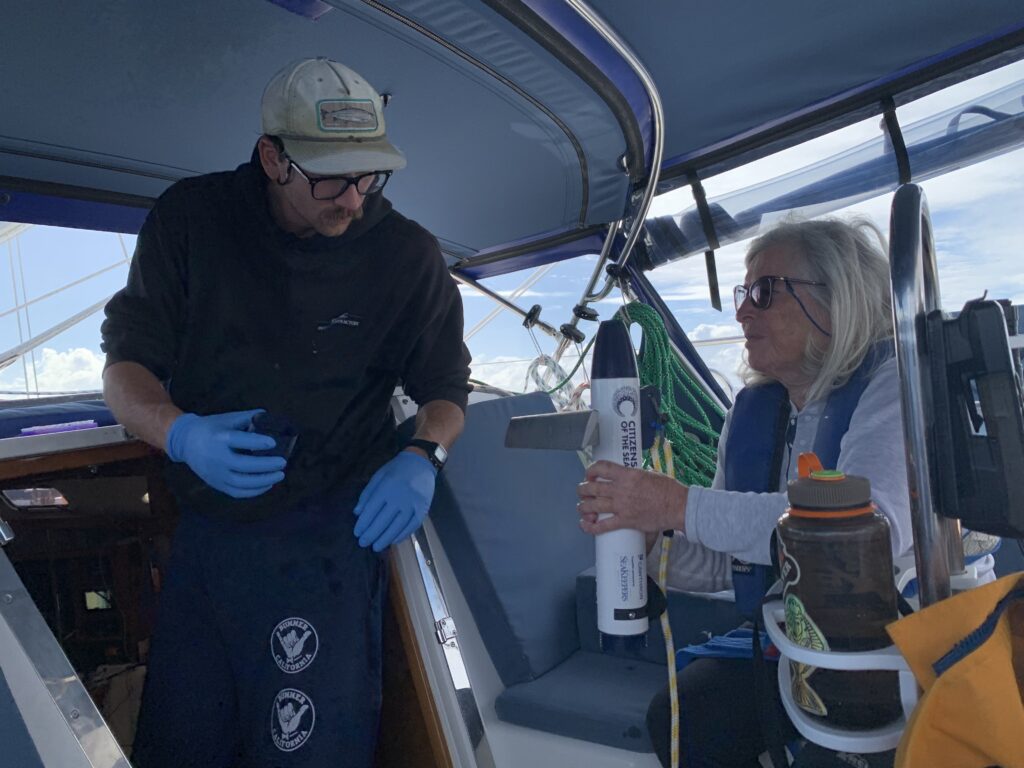
Handing off the torpedo to the lab technician
On Friday, May 24, our 24-hour distance was 150 nautical miles. Winds were light and shifty in the morning and we mostly motored. Squalls brought the winds up to 29 knots a couple of times. Winds were more like 15-18 knots by late morning. The swells were big. We did get a wind shift that let us get back closer to the rhumb line. We played with the jib, furling it in a bit with high winds and letting it out in the calmer winds. By Friday night, the winds were a consistent 18-22 knots with 1-2 meter swells. We had lost AIS contact with the other boats. Antinea was ahead of us and Blue Beryl and Beluga were behind us. One tanker passed us going south. It was a clear night.
By early Saturday morning, the wind had dropped from the high teens to 13 knots with 2-3 meter swells. We often used the motor to compensate for our low speed in those swells. We logged 152 nautical miles for the previous 24 hours. By afternoon, the seas were building. In looking at the weather, we started doubting the stop in Minerva Reef. It was likely that we would be held up there for several days if we stopped. But if we turned toward Fiji, we would have a better sailing angle. So we altered course and headed directly to Fiji, against the advice of our weather router. That day we had a much better sail, on a broad reach with fresh winds of 15-24 knots. Womble had already made that decision and Southern Star would make the same call a few hours later. Later that night, the winds dropped to 5-7 knots and we motor sailed in light swells.
By Sunday morning, we were still motoring in light winds and light swells. During my 2:00 a.m. to 6:00 a.m. shift, we had to slow down to avoid a collision with Antinea, who crossed our bow on their way to Minerva. Also, the tiller pin for the autopilot sheared off, and I had to switch to the backup CPT autopilot. During the day, with light winds more from behind us and a continued swell, we shook out the second reef to have more sail area. Our distance for the previous 24 hours was 140 nautical miles. We put in a new tiller pin and began using the regular autopilot again. In the late afternoon, with really light winds, we put in the third reef and pulled the main in to motor downwind, with no jib. We pushed up the motor RPMs a bit, partly for variability and partly to reach a new waypoint (that John Martin had given us) by dawn on Tuesday. (Once we made the decision to head to Fiji, John began routing us so that we could lessen our exposure to high winds and convection closer to Fiji.)
In mid-afternoon, Johno got word from Dana on Thursday’s Child that they had gone up on a reef in the Southern Lau Group of Fiji, enroute from Minerva Reef. As their communication continued through the night, it was clear that they were in a very serious situation. Even though we were too far away to help them, I was really glad that we were headed to Fiji at that point instead of stuck in Minerva Reef. That night, we had light winds from every direction, a 1-meter swell, a clear night and a big moon.
Monday brought some cloudy weather. We continued to have light winds and slightly larger swells. The winds were coming from the west, which was good, but they weren’t strong enough for us to turn off the motor. We had sailed 139 miles in the previous 24 hours. The water was getting noticeably warmer.
On Tuesday morning, we reached our waypoint around dawn, then turned slightly to the right to head to our next waypoint. The tiller pin for the autopilot sheared off again, and this time we didn’t bother to replace it. We sailed with the CPT autopilot. During the early part of the morning, we were able to turn the engine off and sail with the main and jib. We had gone 157 nautical miles in the previous 24 hours. By evening, winds built to 18-22 knots. We sailed with the third reef in the main and the storm jib. We had 1-2 meter swells following with 1-meter wind waves on the beam. The night was partly cloudy, warm and humid.
Wednesday started out with 12-18 knot winds and 2-meter swells. The CPT was doing well but our speed was low due to the swells. By late morning, the winds and swells were building, with gusts to 28 knots. Johno started hand steering during his shifts. We had gone only 134 nautical miles in the previous 24 hours. During Wednesday night, the swells brought a lot of water into the cockpit. Johno continued to hand steer for each of his four-hour shifts and Stephanie and I would hand-steer two hours on/two hours off during the other eight hours. We would continue to hand steer for the last 33 hours of the passage.
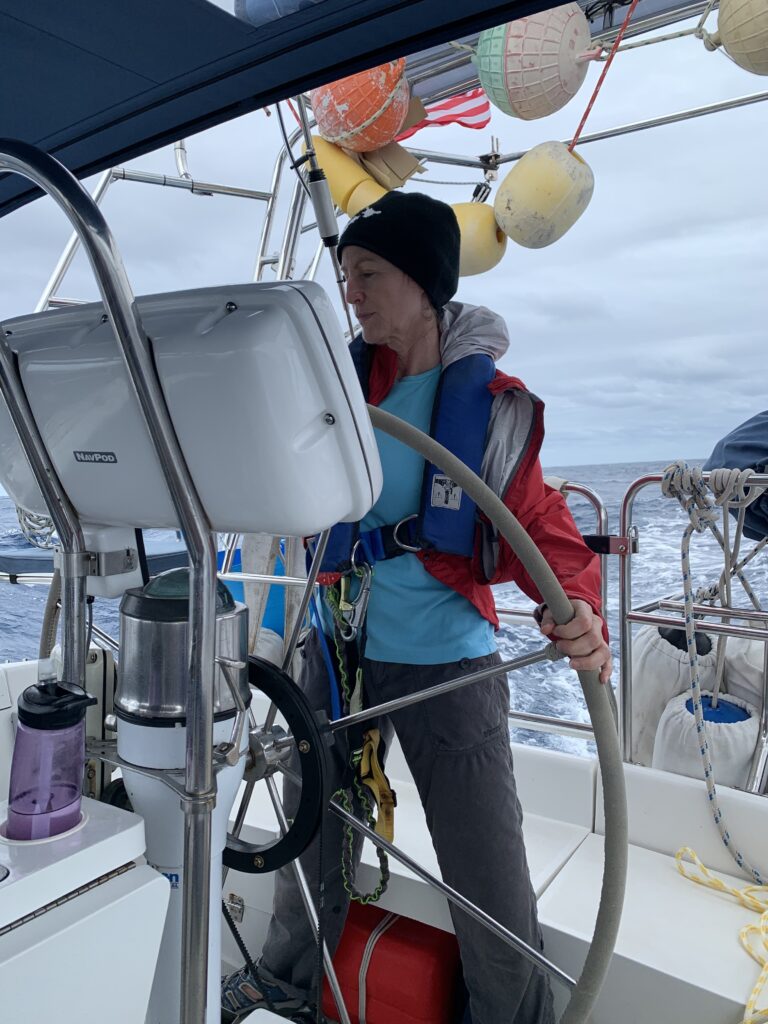
Stephanie at the helm
By Thursday morning, we were getting close to Savusavu. We had gone 138 nautical miles during the previous 24 hours. Womble and Southern Star had arrived early in the morning. We continued motor sailing all day, slowly. The weather was very rainy and cloudy and we had low visibility as we approached land and then made our way along a peninsula toward the marina. We approached the Nawi Marina at around 3:00 p.m. A tender escorted us to the quarantine dock (as did Ian from RaLa in his tender). The officials checked us into the country between 4:00 p.m. and 5:30 p.m. Then we were escorted to our berth. Johno hopped off the boat as soon as we were settled, to make his way to the AirBnB where Thursday’s Child had taken up residence. (They had been taken off the reef and brought to Savusavu by Second Set.) Stephanie and I went up to the restaurant and had dinner with Rhapsody and Pulsar and Second Set before getting a very good night’s sleep.
